Gallery Network
7 Questions for Artist Dominic Harris on ‘Humanizing the Digital’ Through His Interactive Artworks
The artist's solo show "Feeding Conciousness" will be the inaugural exhibition at Halcyon Gallery's London location.
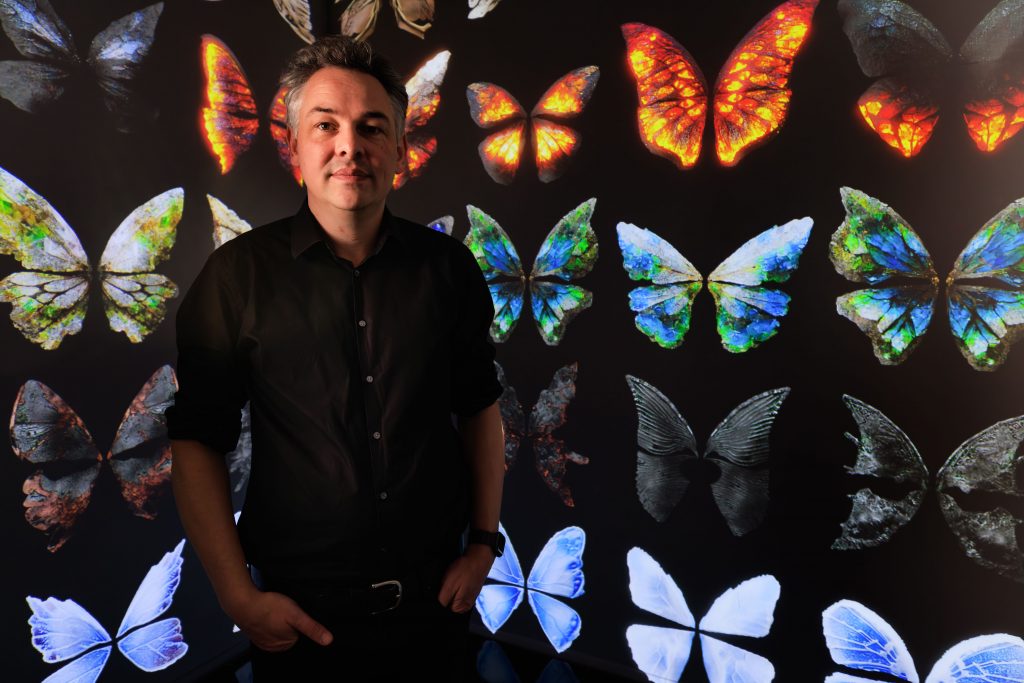
The artist's solo show "Feeding Conciousness" will be the inaugural exhibition at Halcyon Gallery's London location.

Artnet Gallery Network

British artist Dominic Harris (b. 1976) has a practice centered on the intersections found between art, culture, and technology. Using cutting-edge digital tools, Harris’s work offers new ways of seeing—namely how we see current realities as well as possible futures.
A graduate of the Cranbrook Kingswood School in Michigan, as well as University College London where he studied architecture, Harris went on to work for the architectural practice Future Systems in London, and since 2007 has helmed his own studio in Notting Hill. His work has been exhibited internationally, and opening this week he is the subject of the solo show “Feeding Consciousness” at Halcyon Gallery—the inaugural exhibition of the gallery’s new London flagship location. The exhibition will be on view May 25–August 13, 2023, and feature 18 new works that promise to transform “the visitor from viewer to participant.”
Ahead of the opening, we reached out to Harris to learn more about what’s in store for the exhibition and his thoughts on AI and new digital technology in art.
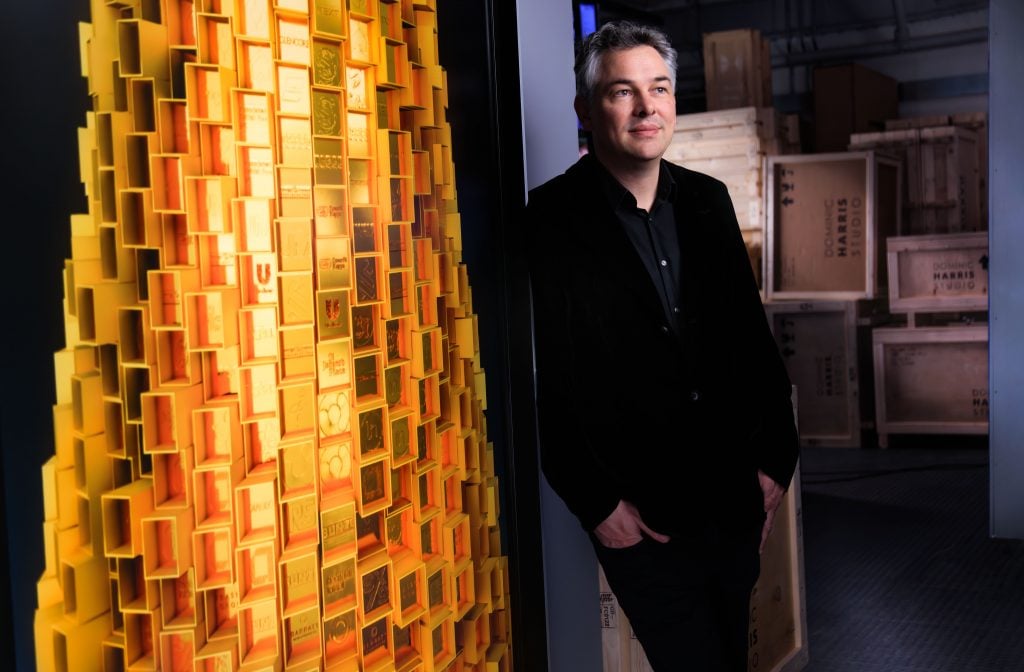
Dominic Harris. Photo: Nicholas Dawkes. Courtesy of Halcyon Gallery, London.
Can you tell us a bit about the themes or inspirations behind your show, “Feeding Consciousness,” opening at Halcyon Gallery’s new flagship space this month?
“Feeding Consciousness” is an exhibition of my new artworks in which I place the viewer unequivocally placed at the heart of each piece. I employ all sorts of technologies operating at varying scales to really immerse the viewer into concepts that encourage a new look at the world around us. I harness global data feeds from global giants like Google and the stock markets, I have delved into the databases of butterfly specimens and other natural phenomena, and I have journeyed back to some of the greatest stories about human perseverance and power.
It is an exhibition about where we collectively are now, but also where we individually have power and influence. The underlying themes are serious, but I investigate and portray them with absolute beauty and optimism. I harness the power of some of the most exciting technologies to temporarily relocate us into the sublime world of narratives brought to life through exquisite execution.
With a mix of screen-based and immersive, multi-sensory works included, what do you hope the viewing experience for visitors to be like? What do you hope they take away with them?
The exhibition will be exciting, and I hope that it catches people by surprise. It’s the biggest-ever launch of new artworks, and I push boundaries and use techniques that, even a few years ago, I didn’t expect to be able to achieve.
My art medium is still rather unique, and my approach even more so. But the stories I tell are timeless, albeit quite re-invented and updated. I very much hope that the artworks fulfil their purpose, which is to engage the viewers and illicit a greater sense of appreciation and awareness of the world around us.
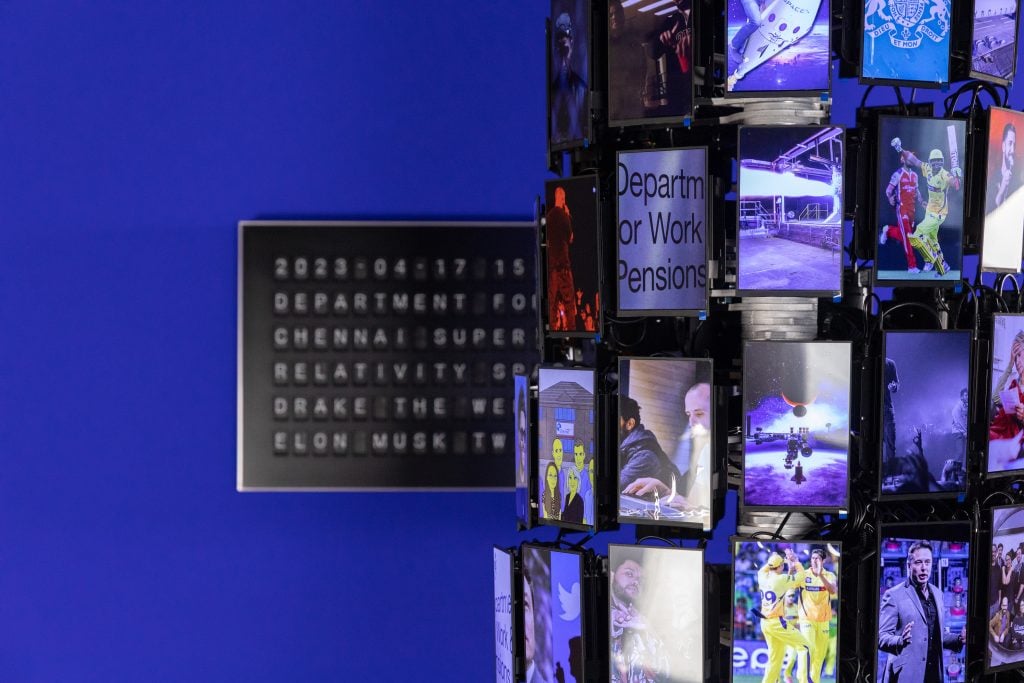
Installation view of “Dominic Harris: Feeding Consciousness” (2023). Courtesy of Halcyon Gallery, London.
Much of your work employs cutting-edge technology, how does the rapidly changing tech landscape influence or inform your practice?
Technology is so deeply infused within each artwork that it is now a truly inseparable part of my palette of materials and techniques. And like any palette, it can be developed and improved over time. Ultimately, what drives me in my creations is always the visual beauty and poetry, and the impact—no matter how ephemeral or visceral – the artwork has on its viewer. That is what makes The Artwork. But, behind the artwork is the technology, which I consider an art form in its own right.
The use of technology within art has always been strong. Painters pioneered new ways to use pigments and make paint, photographers worked out new techniques to capture their images, and sculptors frequently push technical boundaries. While some may find the rapid pace of technological change daunting, for me it is exhilarating. My relentless pursuit to portray the world about us can only benefit from each new increase in technological power that further enhances my palette of materials.
AI has become a hot-button subject recently. How has the use of AI broadened the scope of your practice and what is your opinion on how it is—or will be—used within artmaking more widely?
Recently, there has been a lot of talk about AI generative art—this is the idea that AI can produce images or videos from a written prompt. Rewind just one year and no one was talking about AI in art, or particularly interested in it. But, for me, AI and related tools have been part of my practice for many years now, just not used in a way to generate visual images or videos. Instead, I have been leveraging AI to better understand the subjects I study, to better model movements and behaviors, and to make interpretations and deductions from large data sets.
AI is just one of just many advanced tools that I continuously develop in my technological palette of materials. It is inevitable that AI will become ever more powerful, but it will not replace the role of an independent true creative. I will use AI, but not in a way that would replace me—instead, it will be in a way that augments the ambitions and concepts I am working on, and permits me to create even more incredible and original artworks.
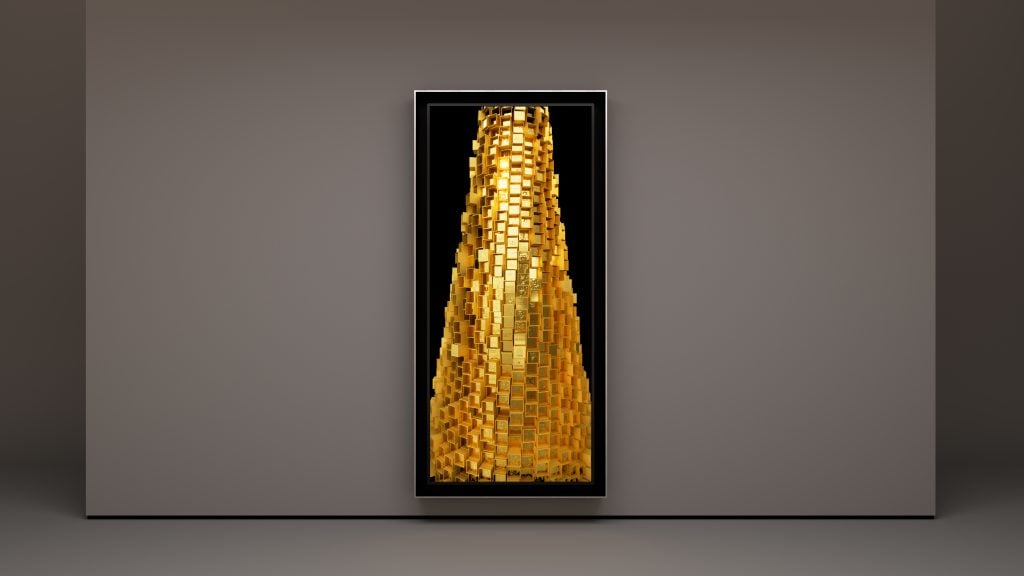
Dominic Harris, Limitless (2023). Courtesy of Halcyon Gallery, London.
What do you think the role of art is in society today?
Art has always played a crucial role in society, and this remains true today. It’s a medium for expression, communication, and exploration. It allows us to reflect on who we are, where we’ve come from, and where we might be going.
In this age of information, we’re constantly bombarded with data, be it news, social media feeds, or stock market trades. We’re living in a data-saturated society. I think that the new digital and interactive art movement can tackle these subjects, just as artists of previous generations investigated and depicted the changes of their time.
Through my work, I aim to make the invisible visible, to bring the abstract into the tangible realm. The data we’re surrounded by every day is so much more than just numbers or headlines. It’s a reflection of our society, our values, our fears, and our hopes. I want to highlight that and to make people stop and think about the information they’re consuming, and how it shapes their understanding of the world.
My new pieces are not just about presenting data in a new form, but also about challenging our relationship with this data. We’re so used to being passive consumers of information. With my interactive, screen-based, and physical work, I’m inviting viewers to become active participants, to engage with the data in a more meaningful way.
In a broader sense, I see these artworks as a bridge between technology and humanity. It is my way of humanizing the digital, and in doing so, to hold up a mirror to society in the greatest tradition of how artists have often strived to do this over the past centuries.
With a background in architecture, what does your creative process look like? What is the most important tool in your studio?
What perhaps would surprise people is how physical my digital work is. My artworks are digital and interactive, but they all have a physicality that places them firmly within human space. I trained and qualified as an architect, and perhaps consequentially have always been drawn to the human scale. I tend to work at a 1:1 scale, or at the very least with an acute awareness of the scale of the viewer relative to the artwork or scene being depicted. The architect in me resurfaces continuously, for example in my absolute fascination with the micro-scalar structure of a butterfly’s wing, or perhaps in understanding and interpreting other physical structures.
My new artworks Limitless and Feeding Consciousness both draw inspiration from the story of the Tower of Babel. In both the architectural form of the fabled tower is reimagined, except in Limitless the structure exists as a wonderful perpetually growing parametric digital architectural form, whereas in Feeding Consciousness it is translated into a physical spiraling structure of aluminum and electronics.
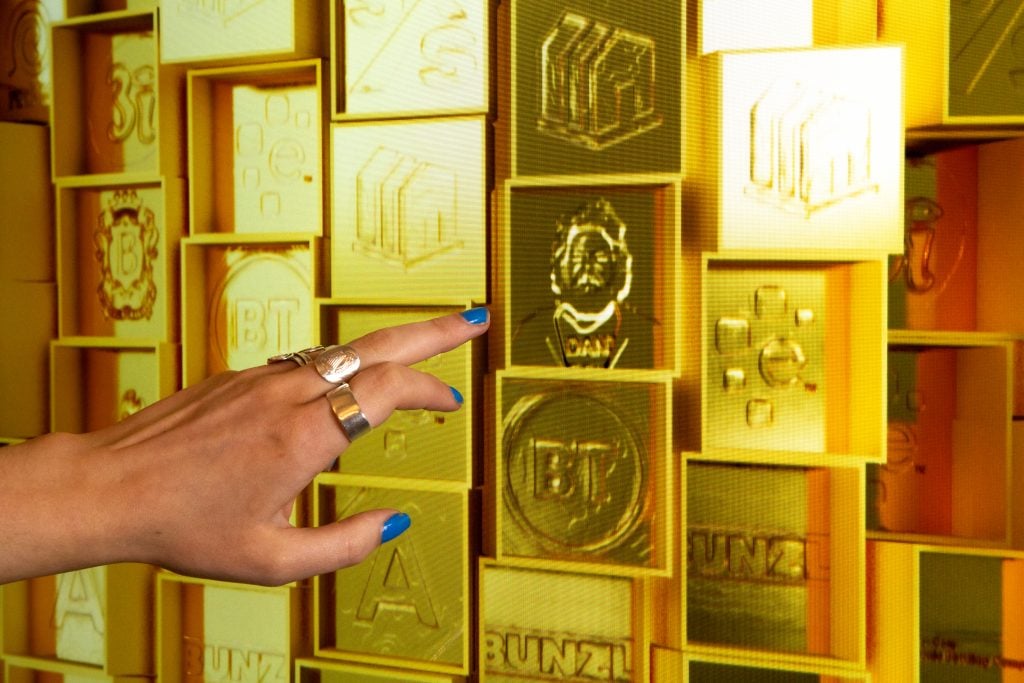
Dominic Harris, detail of Limitless (2023). Courtesy of Halcyon Gallery, London.
What have been your most significant projects, commissions, and collaborations to date?
While most of my work is created speculatively and produced in very limited editions, I do occasionally undertake special commissions and projects. These tend to be very specific, and I look to develop my narratives and concepts to typically site-specific responses or briefs that resonate with me.
Recent examples include the Concentric Study (2015), which was projection-mapped onto the façade of The Grand Palais for Paris art week. The “Son et Lumiere” piece interrogated the underlying architecture through audio-responsive geometric patterns. Working at a large scale is always exciting, and later this year I will be delivering a landmark permanent digital façade for a new city town square project in Canada.
For OurOnyx I created All that Flutters Turns to Gold (2021), a fluttering wall of gold butterflies permanently installed in their flagship locations in London and Dubai. And perhaps the most ambitious of all commissions to date, Every Wing has a Silver Lining (2023) will be unveiled soon in Venice, a silver-shimmering wall that will be one of the largest real-time interactive pieces ever executed.
“Dominic Harris: Feeding Consciousness” is on view at Halcyon Gallery, London, May 25–August 13, 2023.